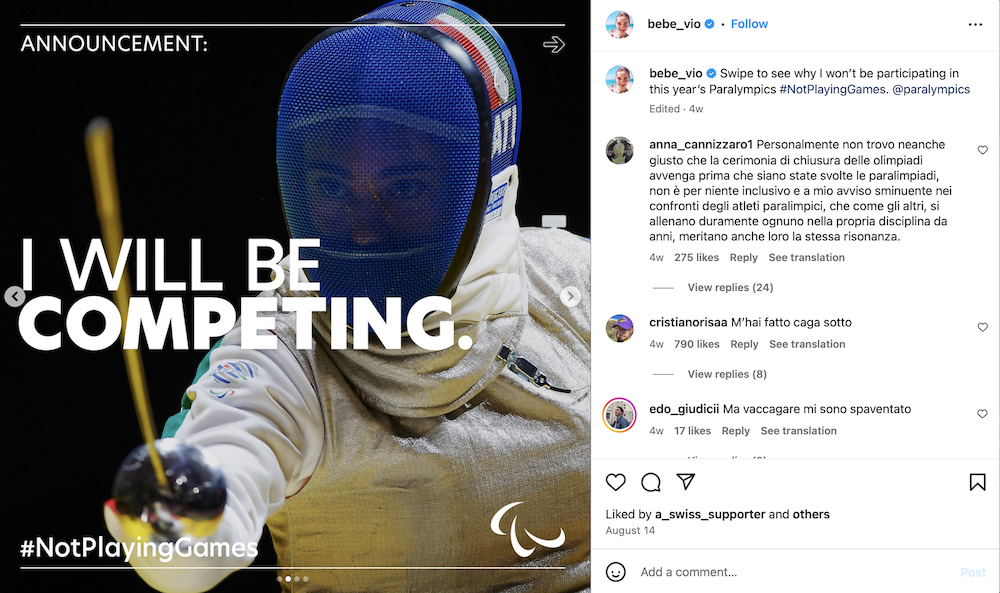
Dr. Filippo Trevisan
Associate Dean and Associate Professor at American University’s School of Communication. He is also the Deputy Director of AU’s Institute on Disability and Public Policy. His research examines how political organizations – parties, campaigns, advocacy organizations, and activist groups – use media to reach, activate, and organize people, especially those from traditionally marginalized and disenfranchised backgrounds.
Email: Trevisan@american.edu
Paris 2024 will go down in Paralympic history as a social media sensation. Although the Olympics continue to receive more traditional media coverage, this year’s Paralympics’ social media content, relative to following size, generated comparable and unprecedented levels of engagement, regularly raking in millions of views. In turn, this intersection of sport, technology, and disability has created new opportunities for advocacy and representation. This was not a coincidence. Rather, these developments can be traced back to a bold social media strategy by the International Paralympic Committee (IPC), centered on TikTok, as well as to a more organic realignment between paralympic sports, disability representation, and the dynamics of Internet celebrity and social change advocacy.
Historically, there has been good degree of ambivalence in the Paralympic movement and among athletes about acting as disability rights advocates or even discussing their lives outside of sport. There are good reasons for that, including the fact that disability has been heavily stigmatized in media and society, which has generated the impression that it is incompatible with celebrity, and the simple fact that taking on any forms of advocacy can expose public figures to a potential backlash. In addition, advocacy that equates with protest has always had a fraught relationship with the Paralympics – as well as the Olympics – and has been relegated outside competition venues such as at the 2012 London games, or more starkly absent like in 2021 in Tokyo.
However, advocacy is changing and a range of less confrontational and more institutionally congenial options have emerged in the last decade, especially online. For example, personal stories are increasingly used as persuasive narratives and Paralympians have focused on disability access needs in partnerships with companies that see this as part of their corporate social responsibility mission. In this context, the IPC has set itself a goal to normalize Paralympic sports and disability itself through social media content, which, in turn, seems to have created a permission structure for several athletes to engage more actively with representations of disability on these platforms. In a previous article, I wrote about the need to bridge the gap between the Paralympics as the most high-profile disability-related event and a new generation of digital-born disabled people who increasingly find their voices online. There is evidence that this has been happening in the lead up to and during the Paris games.
The IPC strategy here has been two-fold. On the one hand, it successfully leveraged the TikTok algorithm to attract a young new audience. Its “secret weapon” here has been comedy, which primarily involved mounting selected video clips from disability sport competitions with audio that creates a comedic effect. Although some have argued that this “mocks” disabled athletes, this strategy has been wildly successful at generating attention and attracting new followers. Moreover, it follows an increasingly established trend by which comedy is used by traditionally marginalized groups themselves – from LGBTQI+ people to people of color – as an innovative and powerful tool to reach new audiences and represent their perspectives. So, the answer to the question “can you really joke about that?!” is, “yes, as long as you laugh with people and not at them.”
On the other hand, the IPC has also sought to empower Paralympic athletes themselves to normalize their experience, for example with template social media content that helped them jokingly announce just days before the Paris opening ceremony that they would no longer “participate” in the games, only to then clarify shortly after that they would, in fact, “compete” (Fig. 1). This was a subtle but smart way to encourage Paralympians to indirectly point out paternalistic stereotypes about disability and contribute to its normalization because it enabled them to do that from the angle from which they likely feel most comfortable with – that of sport. Some have taken this further by participating in campaigns that focus on the contrast between sporting success and everyday life with a disability, such as the #UnofficialDiscipline video, where comedy (e.g. “stairs are one of my least favorite things”) and celebrity are used to highlight barriers and present disability justice as an issue that everyone should care about.

One of the critiques that some have moved against the new Paralympic social media strategy is that, to truly normalize disability, these accounts should be run like those of the Olympics, which have a much more institutional approach. However, this ignores both the structural inequities between the Paralympics and the Olympics, which enjoy a comparative advantage in terms of visibility, as well as social media dynamics where smaller and less-known actors must try something different to break through the noise. This is similar to underdog political candidates that seek to capture attention in a field crowded by influential incumbents. As in politics, new tactics can be controversial but, provided that they include input and are accountable to the disability community, they can yield transformative results.

